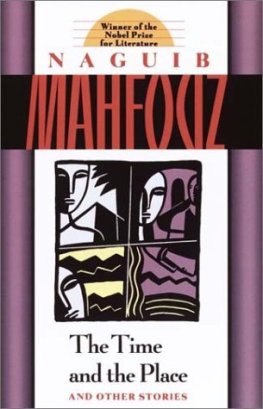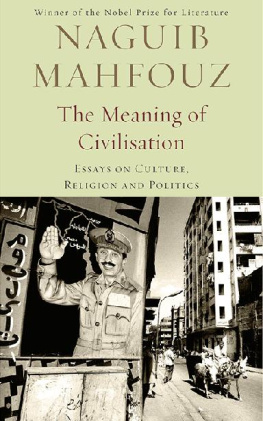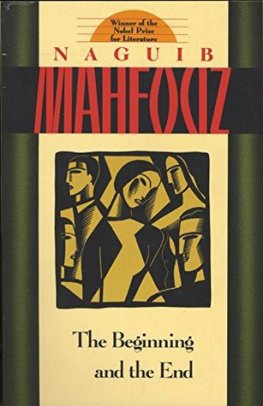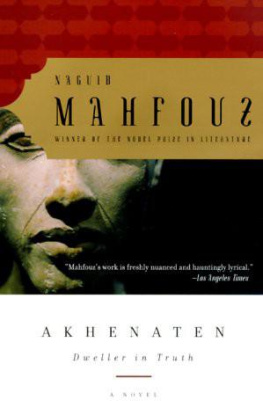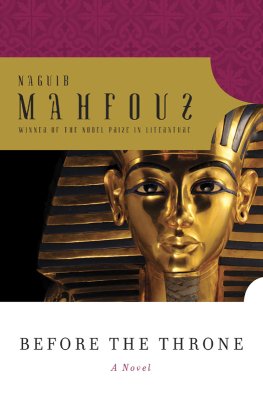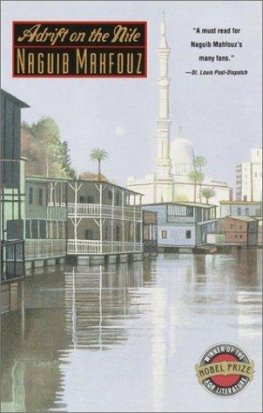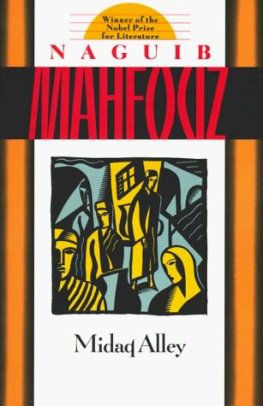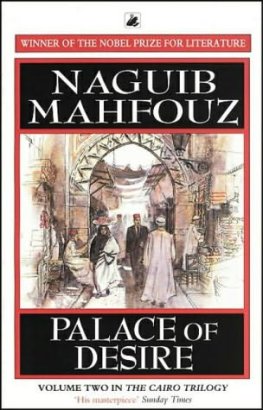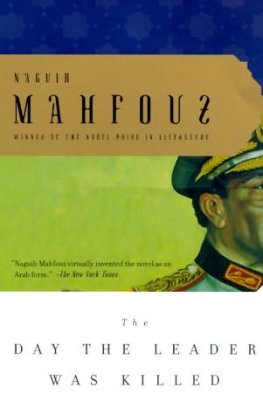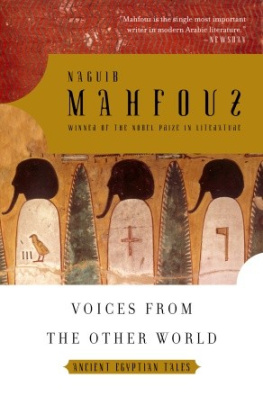nAGUIB mAHFOUZ - Khan Al-Khalili
Here you can read online nAGUIB mAHFOUZ - Khan Al-Khalili full text of the book (entire story) in english for free. Download pdf and epub, get meaning, cover and reviews about this ebook. year: 0, genre: Detective and thriller. Description of the work, (preface) as well as reviews are available. Best literature library LitArk.com created for fans of good reading and offers a wide selection of genres:
Romance novel
Science fiction
Adventure
Detective
Science
History
Home and family
Prose
Art
Politics
Computer
Non-fiction
Religion
Business
Children
Humor
Choose a favorite category and find really read worthwhile books. Enjoy immersion in the world of imagination, feel the emotions of the characters or learn something new for yourself, make an fascinating discovery.
- Book:Khan Al-Khalili
- Author:
- Genre:
- Year:0
- Rating:5 / 5
- Favourites:Add to favourites
- Your mark:
- 100
- 1
- 2
- 3
- 4
- 5
Khan Al-Khalili: summary, description and annotation
We offer to read an annotation, description, summary or preface (depends on what the author of the book "Khan Al-Khalili" wrote himself). If you haven't found the necessary information about the book — write in the comments, we will try to find it.
Khan Al-Khalili — read online for free the complete book (whole text) full work
Below is the text of the book, divided by pages. System saving the place of the last page read, allows you to conveniently read the book "Khan Al-Khalili" online for free, without having to search again every time where you left off. Put a bookmark, and you can go to the page where you finished reading at any time.
Font size:
Interval:
Bookmark:
THE FOLLOWING TITLES BY NAGUIB MAHFOUZ
ARE ALSO PUBLISHED BY ANCHOR BOOKS:
The Beggar, The Thief and the Dogs, Autumn Quail
(omnibus edition)
Respected Sir, Wedding Song, The Search (omnnibus edition)
The Beginning and the End
The Time and the Place and Other Stories
Midaq Alley
The Journey of Ibn Fattouma
Miramar
Adrift on the Nile
The Harafish
Arabian Nights and Days
Children of the Alley
Echoes of an Autobiography
The Day the Leader Was Killed
Akhenaten, Dweller in Truth
Voices from the Other World
Khufus Wisdom
Rhadopis of Nubia
Thebes at War
Seventh Heaven
The Thief and the Dogs
Karnak Caf
Morning and Evening Talk
The Dreams
Cairo Modern
The Cairo Trilogy:
Palace Walk
Palace of Desire
Sugar Street
A t my first meeting with Naguib Mahfouz (d. 2006) in 1969, the discussion began with the topic of translation, but not of his own work. At the time I was revising my doctoral dissertation on the renowned narrative of the Egyptian writer Muhammad al-Muwaylihi (d. 1930), Hadith Isa ibn Hisham (which was originally published in 1907; my translation and study of it eventually appeared in book form as A Period of Time in 1992). Mahfouz was delighted to hear of my interest in that work, since he acknowledged to me that it had long been a favorite of his family and had had a great influence on him as a teenager as, it would appear, it did on another great Egyptian storyteller, Mahmud Taymur (d. 1973). Inevitably, however, the conversation gradually shifted to his own works, and I told him that I had read and greatly admired many of the short stories in his recently published collection, Khammarat al-qitt al-aswad (Black Cat Tavern, 1967). When I asked him if he would allow me to translate some of them, he readily agreed and asked me to make a list of the ones I particularly liked. Once I had recorded the names of five or six stories, he asked if I was interested in any of the novels. Because its political context is set during and after the 1952 revolution, I had recently purchased al-Summan wa-l-kharif (1962; Autumn Quail, 1985), and thus that title was added to the list. Mahfouz signed his name to the paper (which I still cherish in my files), and my career as a translator of Mahfouz began.
In fact, it began, somewhat unusually perhaps, not with his novels, but rather with a collection of short storiesthe ones on the list that I had chosen myself, and others that I proceeded to translate with an Egyptian colleague, Akef Abadir. The collection, Gods World, containing a selection of short stories culled from all his collections up until the year 1970, was published in 1973 and was mentioned in the Nobel Committees citation in October 1988 (although most critics in the Arab world incorrectly assumed that it was a reference to the Arabic collection Dunya Allah (1962), from which we had selected its title story for inclusion in our own collection).
Over the ensuing decades that short story collection was to be followed by my translations of Autumn Quail (1985), Mirrors (1977, 1999, based on al-Maraya, 1972), some individual short stories, and finally Karnak Caf (2007) (a translation of the highly controversial novel, al-Karnak, 1974). This translation into English of Khan al-Khalili (1945), certainly one of the earliest, if not the earliest, of his novels of the 1940s, thus takes me back to a much earlier period in his novelistic output. It is to the impressions that such a return to beginnings has brought about for a translator that I would now like to turn.
The novel, Khan al-Khalili, is named for one of the most famous quarters of the old city of Cairo, the one founded in the tenth century following the invasion of Egypt by Shiite Fatimid forces. The new city was constructed in the area immediately below the Muqattam Hills. At its center was the mosque of al-Azhar, originally established in 972 CE as a center for Shiite learning but one that over the centuries has become a primary source of both education and doctrinal discussion within the Sunni community. However, the most prominent Islamic monument in the Khan al-Khalili quarter itself is the mosqueshrine of al-Husayn, the grandson of the Prophet Muhammad, who was slain during the tragic schism that, within decades of Muhammads death in 632, had split the early Islamic community in two. The mosque itself contains some of the relics of al-Husayn and is thus a shrine frequently visited by devout Muslims, among whom we may list both the father of the Akif family in the present novel and the mother of the Abd al-Gawwad family in Mahfouzs renowned trilogy of novels; during her visit to the al-Husayn shrine, she is knocked down, with tragic consequences for herself and her family, as recounted in Bayn al-qasrayn (1956; Palace Walk, 1990).
The Akif family moves to Khan al-Khalili from the suburb of al-Sakakini, a change that is in the opposite direction to that of the one Mahfouz himself made as a child. Having been born and grown up in al-Gamaliya, equally close to the al-Husayn shrine, his father moved the family to the more rural (at that time, at least) suburb of Abbasiya. However, as any number of articles and television programs have pointed out, Mahfouz never lost his deep and abiding affection for the quarter in which he grew up, and evidence of that is abundant in the descriptions to be found on the pages of Khan al-Khalili, as well as other novels penned during the 1940s and into the 50s, culminating in the trilogy, Bayn al-qasrayn, Qasr al-shawq (1957; Palace of Desire, 1991), and al-Sukkariya (1957; Sugar Street, 1992). Many too are the photographs that show Mahfouz, by now the well-known Egyptian novelist, sitting in the Fishawi Caf in Khan al-Khalili that, like its analogue, the Zahra Caf in the novel Khan al-Khalili, lies in the shadow of the al-Husayn shrine. Is it any wonder then that this novel and the others in this series, with their utterly authentic portraits of every aspect of life in these ancient quarters, continue to hold such a central place in the hearts of Egyptian readers?
In this novel, place plays a crucially important role, as it does in all the other quarter novels, but so does time. Following Mikhail Mikhailovich Bakhtins notion of the chronotope, we can note that the two are almost inevitably linked to each other. The Akif familys move to the Khan al-Khalili quarter is not a voluntary one, but is rather the result of panic caused by a bombing raid. The novels time period is that of the middle of the Second World War, and Khan al-Khalili records in vivid detail the often-neglected direct effects of the Africa Campaign on the Egyptian capital city. The social effects of the war and the continuing British occupation of Egypt (that started following the Urabi Revolt of 1882) are very much to the fore in the long-famous novel, Zuqaq al-Midaqq (1947; Midaq Alley [sic], 1977), in which the climactic scene sees the young Egyptian, Abbas, battered to death by British soldiers as he confronts Hamida, the quarters beauty, who has become a call girl. In Khan al-Khalili however, the impact of the war is, if anything, even more direct and vividly described. The tenants of the neighborhood into which the Akif family moves regularly find themselves being woken up in the middle of the night by the dreadful sound of air-raid sirens. The bomb shelter to which they all descend may be a haven from the potential destruction above, but the descriptions of these panic-stricken hours spent underground are used by Mahfouz as an effective means of portraying the clashing emotions Egyptians feel as they confront the consequences of other peoples wars. The conversations among the group that gathers every night at the Zahra Caf are another device whereby the novelist is able to illustrate the wildly contrasting attitudes of the various social strata of Egyptian society as they react to the war going on around them.
Next pageFont size:
Interval:
Bookmark:
Similar books «Khan Al-Khalili»
Look at similar books to Khan Al-Khalili. We have selected literature similar in name and meaning in the hope of providing readers with more options to find new, interesting, not yet read works.
Discussion, reviews of the book Khan Al-Khalili and just readers' own opinions. Leave your comments, write what you think about the work, its meaning or the main characters. Specify what exactly you liked and what you didn't like, and why you think so.


